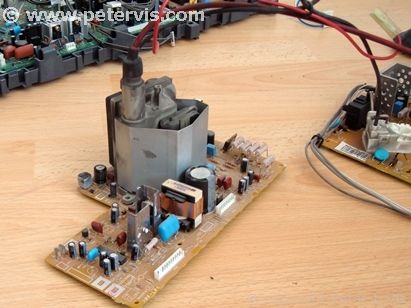Line Output Transformer (LOPT) / Flyback (FBT)

A line-output transformer (LOPT), also known as a "flyback" transformer (FBT) is an electronic component used in television receiver sets and visual display units (VDU) that employ a cathode ray tube (CRT) to display an image. The primary purpose of this transformer was to produce the high voltages necessary for the operation of the CRT. Hence, it is an extremely critical component playing a central role.
An early application of the "flyback" transformer was to generate the high voltages required to drive the deflection coils. These coils required high voltages in the order of hundreds of volts to control the electron beam to scan a raster consisting of 625-lines on the screen. When the last line completes, the beam returns to the top left corner of the screen to start again. A typical television did that 50 times per second, and thus generated 50 frames of images per second. These types of transformers are usually part of the horizontal output stage in the circuit.
Since the positioning of each horizontal line was slightly below the previous, the voltage to the deflection coil had to drop in small discrete steps so that the electron beam positioning was below the previous line. In an oscilloscope, this type of waveform appears as a saw-tooth wave where the slopes of each tooth consist of 625 steps. Hence, an oscillator circuit usually created the necessary voltages to drive the primary winding of this type of transformer.
Horizontal Output Transistor
A horizontal output transistor (HOT) usually energises the primary windings of the LOPT. It is a high voltage, high frequency power transistor, which drives the transformer.
Voltage Rails
The LOPT is a multi-pin device with many independent coil windings that produce voltages for the proper operation of the CRT and television subsystems. A typical transformer produces in the order of 25,000 V DC for the final anode of the CRT, and 10,000 VDC for the focus circuit. In addition, it produces trace-derived high current voltages in the order of 30 V DC for subsystem circuits. Many also produce 18 V, 12 V, 5 V, and 6.3 V for the cathode heater element of the CRT. Therefore as one can imagine this component is critical for the operation of the television circuit.
Fault / Diagnosis

The LOPT operates at high voltages and high frequencies within a circuit and often heats up during normal operation, therefore, it is a component under huge stress, and is usually the one to fail over time.
Failures of the coils occur in the form of shorted windings, where the enamel insulation melts, and the coil shorts. Depending upon the severity of the short, this fault manifests in different symptoms. A non-operational television where the power supply trips usually indicates a failure of the horizontal output transistor and the primary LOPT coil. Checking the transistor usually reveals a short between the collector and emitter junctions, and checking the primary coil, which this transistor drives, indicates a short of the primary windings. However, sometimes, the transistor simply fails due to old age and fatigue.
This Article Continues...
Sony Television KV-36FS76UCathode Ray Tube (CRT)
How does the electron gun inside a TV work?
Deflection Coil
Final Anode
Buy a New Television
Television Integrated Circuits
Sony Television Boards & Components
SCART
Television Computer System
LM1876 Overture™ Audio Power Amplifier
Line Output Transformer (LOPT) / Flyback (FBT)
Sony Television PSU
Degaussing Coils
Sony KV-36FS76U Television Speakers
Sony KV-36FS76U Back Cover
A Television Journey
Sony KV-36FS76U Fault Troubleshooting